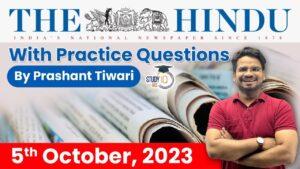The Hindu Newspaper Analysis for UPSC

The Hindu Newspaper Analysis 12 July 2023
- Retail inflation hardened in June to a three-month high of 4.81%, from May’s 4.31%, driven by a spike in food price gains due to the rising costs of items like cereals, pulses, milk and tomatoes. Food price inflation quickened to 4.5%, from less than 3% in the previous month.
- While June’s pace of consumer price gains snapped a four-month streak of moderation from the 6.5% uptick logged in January, urban consumers faced almost 5% inflation last month with food price inflation almost doubling in pace from May’s 2.4% to 4.3%.
- June was the fourth month in a row that retail inflation stayed below the Reserve Bank of India’s (RBI’s) upper tolerance threshold of 6%, but economists opine that the ongoing upturn in vegetable prices and the “flooding plus uneven monsoon” situation could exacerbate food price pressures on headline inflation.

- We continue to monitor a basket of goods that includes torches, radios, tape recorders, CDs, DVDs, audio/video cassettes, and trunks, among some 300 other items. Although these have a minimal weight in the overall CPI calculation, we are clinging onto the past, tracking items that no longer hold the same relevance in our consumption patterns.
- In the current CPI (base year 2012), weights of various groups are as follows: food and beverages (45.86); paan, tobacco and intoxicants (2.38); clothing and footwear (6.53); housing (10.07); fuel and light (6.84); miscellaneous (28.32). The weightage of food in the CPI basket has decreased from 60.9 (in 1960) to 57.0 (in 1982) and to 46.2 (in 2001).
- This gradual decline indicates that as the economy grows, the proportion of income spent on food decreases. This is a common trend known as Engel’s Law, which suggests that as income rises, the proportion of income spent on food falls, even if the absolute expenditure on food rises.




- The South China Sea is a crucial maritime gateway and junction for shipping between the Pacific and Indian Oceans. Any confrontation in the South China Sea, one of the world’s most vital oceans in terms of geopolitics, economy, and strategy, will be a danger to regional and global security.
- As free and stable marine commons are crucial to global trade and economy, India and many other nations have an interest in safeguarding the water lanes that pass through the region.


- After tomato prices rocketed to ₹200 a kg in some cities, the Centre decided on Wednesday to use its agencies to procure stocks from Andhra Pradesh, Karnataka and Maharashtra and sell them at a discount in areas where prices remained high.
- Rain and floods in Himachal Pradesh have caused transportation disruptions, pushing up the price of tomato further in northern cities. Bathinda in Punjab recorded the highest price — ₹203 a kg — in the country on Wednesday. The national average price of the day was ₹111.71. Last year, on the same date, the price was ₹40.83.
- The Department of Consumer Affairs directed the National Agricultural Cooperative Marketing Federation (NAFED) and the National Cooperative Consumers Federation (NCCF) to immediately procure tomatoes from markets in Andhra Pradesh, Karnataka and Maharashtra for distribution in major consumption centres where retail prices have recorded the biggest increase in the past one month. “The stocks of tomato will be distributed through retail outlets at discounted prices to the consumers in Delhi-NCR region by Friday,” a government release said.
- According to data shared by the Ministry, Himachal Pradesh is the only State where tomatoes are harvested in July. The Ministry had said earlier that the increase in price is seasonal and would come down when stocks from Himachal Pradesh reached vegetable markets in the northern parts of the country. “The prices will stay high for the next 15-20 days. It will not go higher,” the official said.
- The Ministry said southern and western regions of the country contribute 56% to 58% of the all-India production.

- About Index of Industrial Production (IIP)
- It is a composite indicator that measures the growth rate of industry groups classified under:
- Broad sectors, namely, Mining, Manufacturing, and Electricity.
- Use-based sectors, namely Basic Goods, Capital Goods, and Intermediate Goods.
- With the inception of the Central Statistical Organization (now known as the National Statistics Office (NSO)) in 1951, the responsibility for compilation and publication of IIP was vested with it.
- Ministry: Ministry of Statistics and Programme Implementation.
- Base year: 2011-2012
- About Eight Core Sectors
- These comprise 40.27% of the weight of items included in the Index of Industrial Production (IIP).
- The eight core sector industries in decreasing order of their weightage: Refinery Products> Electricity> Steel> Coal> Crude Oil> Natural Gas> Cement> Fertilizers.

- What is the NRF?
- Setting up the NRF was one of the key recommendations of the National Education Policy 2020.
- The NRF intends to act as a coordinating agency between researchers, various government bodies and industry, thus bringing industry into the mainstream of research.
- In addition to providing research grants to individuals, the NRF plans to seed, grow and facilitate research in India’s universities, especially State universities, by funding research infrastructure and researchers.
How will it be funded?
- The NRF will operate with a budget of ₹50,000 crore for five years, of which 28% (₹14,000 crore) will be the government’s share, and the remaining 72% (₹36,000 crore) will come from the private sector.
- Out of the government’s share, ₹4,000 crore will be used from the existing Science and Engineering Research Board’s budget, which will be subsumed under the NRF.
- Features of NRF:
- The NRF will be presided by the Prime Minister and consist of 10 major directorates, focusing on different domains of science, arts, humanities, innovation and entrepreneurship.
- The NRF will have an 18-member board with eminent Indian and international scientists, senior government functionaries and industry leaders.
- The NRF will be registered as a society and have an independent secretariat.
- Significance of NRF:
- Democratisation of science funding: NRF will emphasise the funding of projects in peripheral, rural and semi-urban areas, which are neglected and never receive funding for science projects.
- Finding solutions to the big problems facing Indian society: The NRF would promote research not just in the natural sciences and engineering, but also in social sciences, arts and humanities.
- Provides an efficient and integrated management system: For the implementation of the missions such as the supercomputer mission or the quantum mission.


 The Hindu Newspaper Analysis 6 October 2...
The Hindu Newspaper Analysis 6 October 2...
 The Hindu Newspaper Analysis 5 October 2...
The Hindu Newspaper Analysis 5 October 2...
 The Hindu Newspaper Analysis 4 October 2...
The Hindu Newspaper Analysis 4 October 2...

















